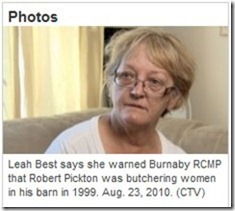Originally printed at http://www.indiancountrytoday.com/home/content/National-call-for-inquiry-into-deaths-of-hundreds-of-Native-women-101643603.html
VANCOUVER, British Columbia – The “Missing Women Investigation Review” released by the Vancouver Police Department Aug. 20 documented widespread deficiencies in investigations of missing and murdered women – no surprise to families who’d been filing reports for more than two decades.
“It’s taken them 19 years to understand what we’ve been saying all along,” said Angela MacDougall, executive director of Battered Women’s Support Services. “We knew what was going on in the ’90s – women were being plucked off the streets. We said there were serial killers, and that women were going missing, and the police did nothing.
“For them to now say ‘sorry, we messed up’ is not good enough. Thirteen more women died because of their bungling, infighting, racism, sexism and jurisdictional issues.”
MacDougall is referring to the failure of police to recognize compelling evidence collected against serial killer Robert Pickton nearly two years before he was eventually charged in the deaths of 20 women, including six Native women. While incarcerated, he bragged he had killed 49 women and “wanted to make it an even 50.”
The 408-page analysis written over several years by Vancouver Deputy Chief Constable Doug LePard concedes police should have recognized there was a serial killer at work since the 1990s, and that a multi-jurisdictional task force including the Royal Canadian Mounted Police should have been created earlier to expand the investigation.
“The RCMP could have gotten involved much earlier and didn’t. … I had $100 million and 180 staff, so imagine (the Vancouver Police Department’s) frustration with eight people,” said RCMP Inspector Don Adam in the report.
The Pickton case had little chance of being solved without RCMP involvement due to the volume of evidence in its jurisdiction and the likelihood that the killer disposed of bodies in rural locations, LePard said.
The need for a coordinated multi-agency response to missing persons cases, and resolving jurisdictional issues were key points in the report’s lengthy recommendations to provincial governments, the Union of British Columbia Indian Chiefs, the RCMP and city officials.
“In every law enforcement jurisdiction in Canada where there are missing women – Winnipeg, Saskatoon, Edmonton, Calgary, Toronto – we’re putting them on notice to get their act together. They face the same jurisdiction conflicts as they had in Vancouver,” MacDougall said.
“We need a full public inquiry and comprehensive analysis, and we need action. Many of these women dealt with violence in childhood and were traumatized as young women. They were failed by adults and police who were supposed to protect them. If Canada doesn’t instigate a public inquiry into their deaths, it will be another failure.”
Dozens of First Nations leaders, women’s advocacy groups, communities and families across Canada are publicly demanding a national inquiry into the 582 known cases of missing and murdered women, as well as hundreds of others that remain a mystery.
Cherry Smiley, a member of the Aboriginal Women’s Action Network said they support the call for a national inquiry into the missing and murdered women and girls, including the mishandling of the Pickton case and abductions along the Highway of Tears in northern British Columbia.
But they also need resources to advance long-term solutions that will get women and girls out of harm’s way. Most organizations providing direct services are struggling on shoestring budgets using scores of volunteers.
“We’re trying to maintain the level of funding we have to do frontline work and it isn’t even close to meeting the needs,” Smiley said.
“We need no-strings-attached funding for women’s groups, more detox beds, a guaranteed livable income, affordable housing, and the implementation of the Nordic model of law in regard to prostitution.
“This type of legislation criminalizes pimps and procurers, the buyers of sex, while decriminalizing prostituted women and children, giving them access to the social services they need to get out.”
AWAN is asking supporters to educate themselves, to write to local and national politicians, to support independent women’s groups like Vancouver Rape Relief and Women’s Shelter, and to support First Nations leadership’s efforts to end the violence.
Men can examine their own sexist and racist behavior and challenge the behaviors of their male friends, Smiley said.
“We are also demanding that Canada sign onto the United Nations Declaration on the Rights of Indigenous Peoples that contains many provisions for protecting our women and children,” said Laura Holland of AWAN.
Tonya Gonnella Frichner, an Onondaga attorney and member of the United Nations Permanent Forum on Indigenous Issues said Canada must respond to requests from the U.N. Committee on the Elimination of Racial Discrimination to document what it has done to improve the situation.
“What we know is that in Canada there’s evidence that there are more than 582 aboriginal women missing and murdered. In the United States homicide is the third leading cause of death for Native women, and one in three will be raped in her lifetime,” she said.
“What we need to know is when it will stop. When will indigenous women of North America enjoy a life expectancy of more than 47 years of age?”
Beverley Jacobs, past president of the Native Women’s Association of Canada, said greater awareness is needed for the public to understand the larger issues behind why this is occurring.
Jacobs also noted that concerned people can help with the needs of families of the missing and murdered. Resources are required to assist with searches, to assist families during a court process, to assist in healing families, to provide education on the issue of violence and to assist with preventative measures.
“Aboriginal women have been targets since colonization and this has impacted so many generations. It is time that aboriginal women take their rightful place in society as leaders, decision makers, teachers, nurtures and life-givers.
“The silence about violence and the outright targeting of aboriginal women has to stop now. Everyone has to take responsibility, including governments, police, media, families and communities.”
